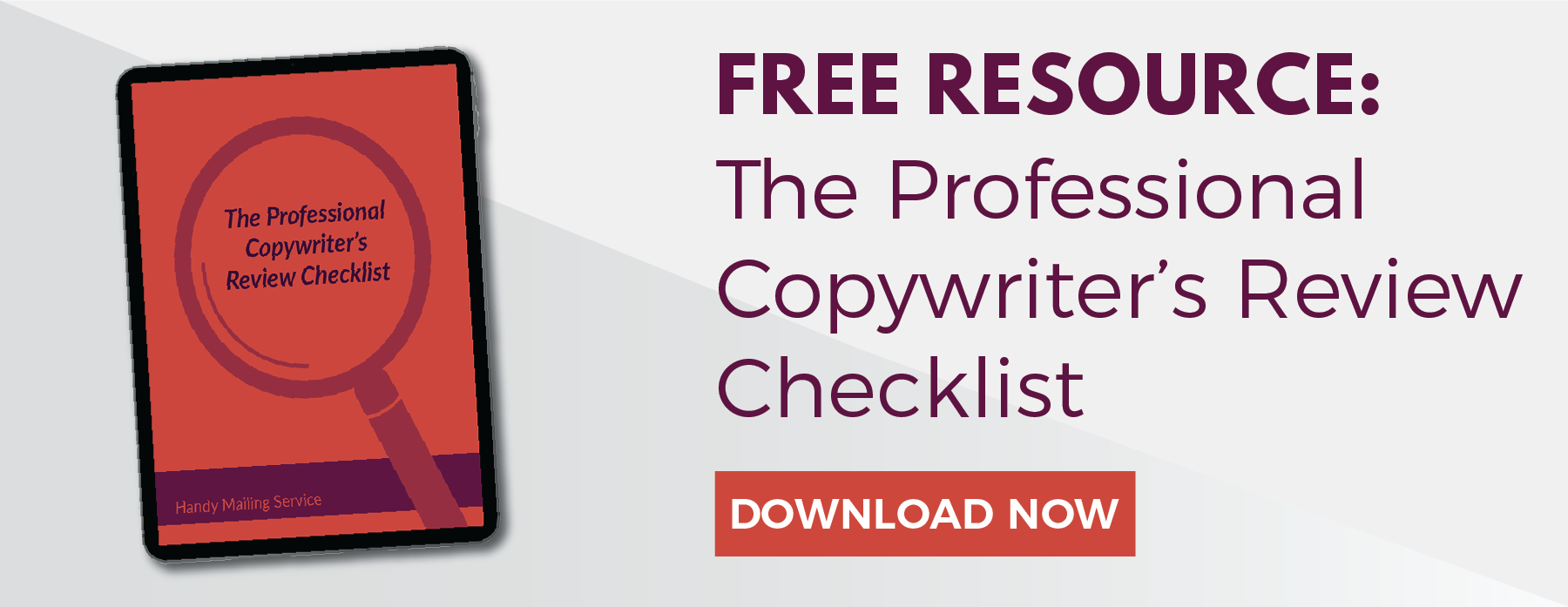When creating and mailing any direct mail campaign, it’s critical that you have a system set in place to review all components of your mail piece before mailing. Without this system, you might miss out on some obvious mistakes or points that would improve your mail piece. This can be especially true if you’re executing the whole campaign by yourself. Without anyone else to provide you feedback, you might not be maximizing the impact of your campaign.
This professional copywriter’s checklist will help you nail down every detail of the sales piece to guarantee the best results. With accountability to the little things that matter, you’ll be confident that you’ve done all you can.
Download this printable checklist to use on your mail piece now!
As a preface, this checklist generally applies to sales letters that are mailed in envelopes. However, these general ideas and checkpoints will be useful to evaluate any mail piece.

Package Description
Starting with the appearance of the envelope, does it look enticing? Your goal is for the recipient to open it, so how is the appearance encouraging that. Have you included any teaser copy? This can be used to quickly identify and qualify the prospect. Effective teaser copy will let the recipient know that what’s inside the envelope is going to be beneficial and applicable to them.
Once inside, does the headline compel the reader to go on? Headlines that work often give exciting news, make a promise, or offer a benefit to the reader. Following the headline, is there a strong lead sentence that picks up from the headline or the teaser copy on the outside?
How well does the opening paragraph lead the reader on the route to a sale? Have you shown the reader how they can benefit in practical terms? It’s important that you expand on the benefits that you’ve told the reader about.
As the reader goes on, have you backed up any claims with success stories, charts, figures or testimonials? Without showing the reader the evidence of your product or service, you can lose credibility or authority as a writer.
Lastly, have you made it obvious why your product or service is going to help your reader? Make sure you describe those benefits and explain how your product is better than the competition. Give them a reason for immediate response and a clear call to action they can take. Is it clear to the reader, what their next step to is? You should make this a strong point of emphasis to encourage immediate action!
Content Evaluation
Throughout your sales piece, have you used the “you” perspective? You need to talk to the reader about their needs and problems from their perspective. If you jump in too quickly about who you are and what you want them to buy, it’s going to turn your reader off. They want to know what’s in it for them and how you can solve their problem.
Does your copy read smoothly and transition between ideas? Have you written it in a sincere and conversational voice? You may need to go back and reword sentences if it sounds too “academic” or wordy. If you wouldn’t say it in a face-to-face conversation, it probably doesn’t belong in your letter.
Does your copy express your enthusiasm about your product or service? If you can’t get excited about what you have to offer, there’s no way your reader is going to be either. To encourage the reader to go to the end, it needs to hold their interest all the way through.
Writing Style
One of the more obvious things to check for is grammar and punctuation. Have you gone through and double-checked everything? It’s important to not only check for correctness but also for impact. If the word or sentence doesn’t add anything to the letter, take it out! Your writing needs to be dynamic and active. Check to make sure you’ve written in an active tense.
Have you included word pictures like metaphors, similes, and analogies? These can be effective in creating emotionally stimulating images. Another way to keep your writing active is by deleting common adverbs such as “very,” “just,” and “really.” Filler words like these detract from the impact your letter is making.
Take a look at your sentence length and reading level. You want to avoid run-on sentences and other sentences that get too wordy. It’s a good idea to keep most of your sentences under 20 words. This helps you keep a steady flow and pace as they read along. If the vocabulary is too complex, you can lose the reader. A general rule of thumb is to write at an 8th-grade reading level or below.
Appearance
How is your placement of text on the letter? Is there enough space between the text and the edge of the piece, or graphics? There should be plenty of “white space” between the text so the reader’s eyes can move around freely on the paper. Cut all distractions that keep the reader from moving to the next paragraph. This could be a background image, graphic, different fonts, or a lack of contrast.
Do your subheads perform well for visual and strategic purposes? Subheads can be the guide rails for your reader as they walk along through your letter. With these placed in the right spots, your reader will stay on track and focused throughout.
Have you created points of emphasis using all caps or a second color? By using ALL CAPS, you can highlight an important phrase or benefit. Or back up a strong argument using a second color to differentiate it from the rest of the piece. Lastly, have you used “leading” words at the bottom of the page so your reader must turn the page to get the meaning? Something as small as this can be the difference in your letter.
Overall Evaluation Of The Piece
With all things considered, how would you rate your mail piece on a scale of 1-10? With that score in mind, where are some areas that you can improve before mailing? Recognizing these areas of improvement will make a positive difference with the results of your campaign. As a final review, here are five checkpoints that you must agree with before proceeding to mail.
- Your offer is clear as presented.
- The pieces in your package complement each other in the right way.
- You have separated yourself from the competition.
- Your product/service/publication/ministry is marketable through direct mail.
- Your strategy, product, service or publication can and should be improved before you continue marketing.



